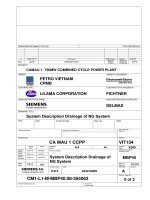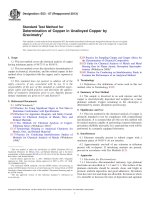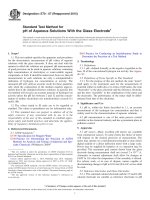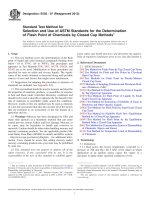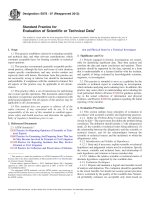E 53 07 (2013)
Bạn đang xem bản rút gọn của tài liệu. Xem và tải ngay bản đầy đủ của tài liệu tại đây (88.09 KB, 4 trang )
Designation: E53 − 07 (Reapproved 2013)
Standard Test Method for
Determination of Copper in Unalloyed Copper by
Gravimetry1
This standard is issued under the fixed designation E53; the number immediately following the designation indicates the year of original
adoption or, in the case of revision, the year of last revision. A number in parentheses indicates the year of last reapproval. A superscript
epsilon (´) indicates an editorial change since the last revision or reapproval.
This standard has been approved for use by agencies of the Department of Defense.
1. Scope
E255 Practice for Sampling Copper and Copper Alloys for
the Determination of Chemical Composition
E1024 Guide for Chemical Analysis of Metals and Metal
Bearing Ores by Flame Atomic Absorption Spectrophotometry (Withdrawn 2004)3
E1601 Practice for Conducting an Interlaboratory Study to
Evaluate the Performance of an Analytical Method
1.1 This test method covers the chemical analysis of copper
having minimum purity of 99.75 % to 99.95 %.
1.2 This test method covers the electrolytic determination of
copper in chemical, electrolytic, and fire refined copper. In this
method silver is deposited with the copper, and is reported as
copper.
1.3 This standard does not purport to address all of the
safety concerns, if any, associated with its use. It is the
responsibility of the user of this standard to establish appropriate safety and health practices and determine the applicability of regulatory limitations prior to use. Specific precautionary statements are given in 8.4 and Section 9.
3. Terminology
3.1 Definitions—For definitions of terms used in this test
method, refer to Terminology E135.
4. Summary of Test Method
4.1 The sample is dissolved in an acid mixture and the
copper is electrolytically deposited and weighed on a tared
platinum cathode. Copper remaining in the electrolyte is
determined by atomic absorption spectroscopy.
2. Referenced Documents
2.1 ASTM Standards:2
E29 Practice for Using Significant Digits in Test Data to
Determine Conformance with Specifications
E50 Practices for Apparatus, Reagents, and Safety Considerations for Chemical Analysis of Metals, Ores, and
Related Materials
E121 Test Methods for Chemical Analysis of CopperTellurium Alloys (Withdrawn 2010)3
E135 Terminology Relating to Analytical Chemistry for
Metals, Ores, and Related Materials
E173 Practice for Conducting Interlaboratory Studies of
Methods for Chemical Analysis of Metals (Withdrawn
1998)3
5. Significance and Use
5.1 This test method for the chemical analysis of copper is
primarily intended to test for compliance with compositional
specifications. It is assumed that all who use this method will
be trained analysts capable of performing common laboratory
procedures skillfully and safely. It is expected that work will be
performed in a properly equipped laboratory.
6. Interferences
6.1 Elements normally present in refined copper with a
minimum purity of 99.85 % do not interfere.
6.2 Approximately one-half of any selenium or tellurium
present will co-deposit. If interfering amounts are present,
proceed in accordance with Test Methods E121.
1
This test method is under the jurisdiction of ASTM Committee E01 on
Analytical Chemistry for Metals, Ores, and Related Materials and is the direct
responsibility of Subcommittee E01.05 on Cu, Pb, Zn, Cd, Sn, Be, Precious Metals,
their Alloys, and Related Metals.
Current edition approved Oct. 1, 2013. Published October 2013. Originally
approved in 1946. Last previous edition approved in 2007 as E53 – 07. DOI:
10.1520/E0053-07R13.
2
For referenced ASTM standards, visit the ASTM website, www.astm.org, or
contact ASTM Customer Service at For Annual Book of ASTM
Standards volume information, refer to the standard’s Document Summary page on
the ASTM website.
3
The last approved version of this historical standard is referenced on
www.astm.org.
7. Apparatus
7.1 Electrodes for Electroanalysis:
7.1.1 Electrodes—Recommended stationary type platinum
electrodes are described in 7.1.2 and 7.1.3. The surface of the
platinum electrodes should be smooth, clean, and bright to
promote uniform deposition and good adherence. Deviations
from the exact size and shape are allowable. In instances where
it is desirable to decrease the time of deposition and agitation
Copyright © ASTM International, 100 Barr Harbor Drive, PO Box C700, West Conshohocken, PA 19428-2959. United States
1
E53 − 07 (2013)
a 250-mL beaker, add 10 mL of HNO3 (1 + 1) and cover. After
dissolution, warm to dispel fumes, cool, transfer to a 1-L
volumetric flask, dilute to volume, and mix.
of the electrolyte is permissible, a generally available, rotating
type of electrode may be employed. Cleaning of the electrode
by sandblasting is not recommended.
7.1.2 Cathodes—Platinum cathodes may be either open or
closed cylinders formed from sheets that are plain or
perforated, or from gauze. Gauze cathodes are recommended;
preferably from 50-mesh gauze woven from approximately
0.21 mm diameter wire. The top and bottom of gauze cathodes
should be reinforced by doubling the gauze about 3 mm onto
itself, or by the use of platinum bands or rings. The cylinder
should be approximately 30 mm in diameter and 50 mm in
height. The stem should be made from a platinum alloy wire
such as platinum-iridium, platinum-rhodium, or platinumruthenium, having a diameter of approximately 1.3 mm. It
should be flattened and welded the entire length of the gauze.
The overall height of the cathode should be approximately 130
mm. A cathode of these dimensions will have a surface area of
135 cm2 exclusive of the stem.
7.1.3 Anodes—Platinum anodes may be a spiral type when
anodic deposits are not being determined, or if the deposits are
small (as in the electrolytic determination of lead when it is
present in concentrations below 0.2 %). Spiral anodes should
be made from 1.0-mm or larger platinum wire formed into a
spiral of seven turns having a height of approximately 50 mm
and a diameter of 12 mm with an overall height of approximately 130 mm. A spiral anode of these dimensions will have
a surface area of 9 cm2. When both cathode and anode plates
are to be determined, the anodes should be made of the same
material and design as the electrode described in 7.1.2. The
anode cylinder should be approximately 12 mm in diameter
and 50 mm in height and the overall height of the anode should
be approximately 130 mm. A gauze anode of these dimensions
will have a surface area of 54 cm2 exclusive of the stem.
7.2 Atomic Absorption Spectrometer:
7.2.1 Determine that the atomic absorption spectrometer is
suitable for use as described in Guide E1024. The variability
for the highest calibration solution should not exceed 1 %.
7.2.2 Operating Parameters:
Wavelength
Bandpass
Gas mixture
Flame type
8.2 Copper, Standard Solution B (1 mL = 0.20 mg Cu)—
Using a pipet, transfer 20 mL of copper Solution A to a 100-mL
volumetric flask, dilute to volume, and mix.
8.3 Sulfuric-Nitric Acid Mixture—While stirring, slowly add
300 mL of H2SO4 to 750 mL of H2O. Cool to ambient
temperature, and while stirring, add 210 mL of HNO3.
8.4 Potassium Cyanide Solution (100 g/L)—Dissolve 100 g
of KCN in water and dilute to 1 L. (Warning—The
preparation, storage, and use of KCN require care and attention. Avoid inhalation of fumes and exposure of the skin to the
chemical and its solutions. Work in a well-ventilated hood.
Refer to the applicable section of Practices E50.)
8.5 Sulfamic Acid Solution (100 g/L)—Dissolve 10 g of
sulfamic acid (HNH2SO3) in water and dilute to 100 mL.
Prepare fresh daily.
9. Hazards
9.1 For precautions to be observed in this method, refer to
Practices E50.
9.2 Cyanides must be disposed of with care, avoiding
contact with acids that release hydrogen cyanide gas.
10. Sampling
10.1 For procedures in sampling refer to Practice E255.
However, this practice does not supersede any sampling
requirements specified in a specific ASTM material specification nor preclude a procedure agreed upon by the producer and
consumer.
10.2 For all trace element determinations, care must be
taken to limit sample exposure to contaminations, and to
remove any contaminations that occur.
10.3 Wherever possible, non-metallic tools shall be used to
obtain chips (millings, drillings, sawings, nibblings, and so
forth) from the sample.
327.5 nm
About 0.2 nm
Air-acetylene
Lean
10.4 Except for the estimation of oxygen or hydrogen, or
when analyzing standard reference materials that forbid
cleaning, the chips shall be cleaned prior to weighing a portion
for analysis. Immerse in HNO3 (1 + 3), rinse in running water
followed by distilled or deionized water and alcohol, and allow
to air-dry. Exercise great care to prevent re-contamination of
the specimen by metal tools, or from zinc in rubber stoppers, or
chlorides from HCl vapor, and so forth.
7.2.3 Instrument Response—Adequate instrument response
is obtained if the difference between the readings of the two
highest of five equally spaced calibration solutions is sufficient
to permit an estimation equivalent to one twentieth of the
difference.
7.2.4 Curve Linearity—The upper limit of the usable portion of a calibration curve is normally set such that the
difference between the readings of the two highest of five
equally spaced calibration solutions is more than 0.7 times the
difference between the lowest of the calibration solutions.
Absorbance values are used in this calculation.
7.3 Glassware, shall be borosilicate glass unless otherwise
stated.
10.5 In methods for the determination of impurities in
copper, particular care must be taken to prevent specimen
contamination by reagents or glassware.
10.6 The interior of glassware shall be cleaned immediately
prior to use by a rinse in HNO3 (1 + 3) followed by running
water and by distilled or deionized water, all in an area free
from HCl fumes.
8. Reagents
8.1 Copper, Standard Solution A (1 mL = 1.0 mg Cu)—
Transfer 1.000 g of electrolytic copper (purity: 99.9 % min) to
10.7 Reagent acid should be taken from a bottle reserved for
trace metal analysis. Extra-purity acids, intended for trace
metal analysis are recommended but not required.
2
E53 − 07 (2013)
TABLE 1 Statistical Information—Copper
11. Rounding Calculated Values
11.1 Calculated values shall be rounded to the desired
number of places, as directed in Practice E29, including as an
option, the special rounding off to a nearest final number of
five.
Test
Specimen
Copper
Found, %
S min
(E1601)
R
(E1601)
%R
(E1601)
1. Copper
2. Copper
99.959
99.723
0.008
0.009
0.023
0.051
0.02
0.05
12. Interlaboratory Studies
12.1 This test method has been evaluated in accordance
with Practice E173 unless otherwise noted in the precision and
bias section.
14.6.1 Calibration:
14.6.1.1 Calibration Solutions—Using pipets, transfer 5, 10,
15, 20, and 25 mL portions of copper Solution B to 250-mL
volumetric flasks. Add 20 mL of H2SO4 (1 + 1), dilute to
volume, and mix. These are equivalent to 0.001, 0.002, 0.003,
0.004, and 0.005 g of Cu/250 mL.
14.6.1.2 Reference Solution—Transfer 20 mL of H2SO4 to a
250-mL volumetric flask, dilute to volume, and mix.
14.6.2 Analysis:
14.6.2.1 Test Solution—If necessary evaporate the spent
electrolyte from 14.5 to below 250 mL and cool. Transfer to a
250-mL volumetric flask, dilute to volume, and mix.
14.6.2.2 Measurements—Optimize the response of the
instrument, take preliminary readings, and complete the analysis and determine the grams of copper in 250 mL by one of the
procedures, graphical, ratio, or single point in accordance with
Guide E1024.
13. Preparation of Electrodes
13.1 Cathode—Clean the cathode in hot nitric acid (HNO3),
(1 + 1), rinse with distilled water, rinse in two separate baths of
ethanol or acetone. Dry at a low temperature (110 °C for 3 to
5 min), and cool to room temperature in a desiccator.
13.2 Anode—Clean in hydrochloric acid (HCl), (1 + 1),
rinse with distilled water.
13.3 Weigh the cathodes to the nearest 0.1 mg and record
the weight. The anode does not have to be weighed.
14. Procedure
14.1 Clean the metal that is to be analyzed in KCN solution.
Rinse with water, then alcohol, and air-dry thoroughly at
ambient temperature.
15. Calculations
15.1 Calculate the weight of deposited copper as follows:
14.2 Transfer 5 g of the cleaned metal, weighed to the
nearest 0.1 mg, to a 400-mL tall-form beaker. Add 45 mL of the
H2SO4-HNO3 mixture and immediately cover with a close
fitting cover glass. Cool as required to prevent the reaction
from becoming violent. When the reaction has subsided, heat
moderately until dissolution is complete. Continue heating at
approximately 90 °C until the brown fumes are expelled. Never
boil. Cool slightly and carefully wash down the cover glass and
sides of the beaker. Add 10 mL of sulfamic acid solution, stir,
and dilute to approximately 175 to 200 mL.
Copper, g 5 A 2 B
(1)
where:
A = weight of cathode plus deposited copper, g, and
B = weight of cathode, g.
15.2 Calculate the percentage of copper as follows:
Copper, % 5 ~~ C1D ! /E ! 3 100
(2)
where:
C
= grams of deposited copper found in 15.1,
D
= grams of copper in 250 mL of electrolyte found in
14.6.2.2, and
E
= grams of sample used.
14.3 With the electrolyzing current off, position the anode
and the tared cathode, weighed to the nearest 0.1 mg, in the
solution and add water so that the gauze is completely
immersed. Cover the beaker with a split cover glass.
14.4 Electrolyze at a current density of about 0.6 A/dm2
(Note 1). When the solution becomes colorless, wash down the
cover glass, electrode stems, and sides of the beaker, add 10
mL of sulfamic acid, and continue the electrolysis until
deposition is essentially complete, as indicated by failure to
plate on a new surface of the cathode stem when the solution
level is raised.
16. Precision and Bias4
16.1 Precision—Six laboratories cooperated in testing this
method and obtained the data summarized in Table 1. The
interlaboratory test was conducted in accordance with Practice
E173 and calculated using Practice E1601 software.
16.2 Bias—No certified reference materials suitable for
testing this test method were available when the interlaboratory
testing program was conducted. The user of this test method is
encouraged to employ accepted reference materials, if
available, to validate the test method as implemented in a
specific laboratory and to obtain estimates of uncertainty due to
bias.
NOTE 1—When a current density of 0.6 A/dm2 is used, the electrolysis
requires about 16 h and is conveniently carried out overnight.
14.5 Wash the cathode with a stream of water as it is being
removed from the spent solution. Immediately wash successively in two baths of water and two baths of ethanol or
methanol. Reserve the electrolyte. Dry at 110 °C for 3 to 5 min,
cool to ambient temperature, and weigh.
14.6 Determination of the Residual Copper in the Electrolyte by Atomic Absorption Spectrometry:
4
Supporting data have been filed at ASTM International Headquarters and may
be obtained by requesting Research Report RR:E01-1089.
3
E53 − 07 (2013)
17. Keywords
17.1 copper; copper concentration
ASTM International takes no position respecting the validity of any patent rights asserted in connection with any item mentioned
in this standard. Users of this standard are expressly advised that determination of the validity of any such patent rights, and the risk
of infringement of such rights, are entirely their own responsibility.
This standard is subject to revision at any time by the responsible technical committee and must be reviewed every five years and
if not revised, either reapproved or withdrawn. Your comments are invited either for revision of this standard or for additional standards
and should be addressed to ASTM International Headquarters. Your comments will receive careful consideration at a meeting of the
responsible technical committee, which you may attend. If you feel that your comments have not received a fair hearing you should
make your views known to the ASTM Committee on Standards, at the address shown below.
This standard is copyrighted by ASTM International, 100 Barr Harbor Drive, PO Box C700, West Conshohocken, PA 19428-2959,
United States. Individual reprints (single or multiple copies) of this standard may be obtained by contacting ASTM at the above
address or at 610-832-9585 (phone), 610-832-9555 (fax), or (e-mail); or through the ASTM website
(www.astm.org). Permission rights to photocopy the standard may also be secured from the ASTM website (www.astm.org/
COPYRIGHT/).
4
